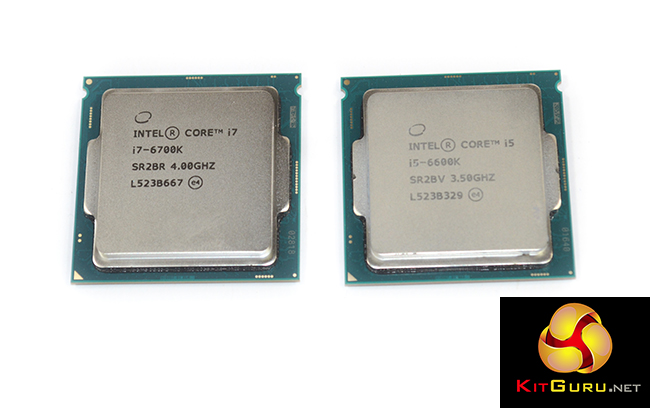With clear IPC gains over the popular Haswell micro-architecture that it realistically replaces, the suggestion of consistently greater overclocking headroom, and the lure of a new feature-heavy platform chipset, it is easy to respect the improvements that Intel's Skylake processors bring to the market.
Let's not fool ourselves – Skylake's IPC gains over yesteryear's Devil's Canyon and its Haswell micro-architecture are nowhere near the same levels that we saw Sandy Bridge bullishly fetch to market all those years ago. But the Devil's Canyon iterations of Haswell were fast, powerful processors in their own right, so performance improvements towards a level of 10% are positive to see. Those performance boosts are significant enough to allow a stock-clocked Skylake Core i7-6700K to outperform a stock-clocked Devil's Canyon 4790K despite the former's 200MHz frequency deficit.
On the other hand, it could be argued that IPC improvements towards a level of 10% do not exactly spell huge innovation for a new architecture, process node shrinkage to 14nm, and a 2-year later release when comparing to Haswell.
Overclocking potential of the Skylake processors is very good. We managed to hit a straightforward 4.8GHz with our i7-6700K which, from what we have discussed, seems to be a consistent level for the i7 when a 1.4V core voltage is used. Our i5-6600K sample was a little less favourable on the overclocking gains, although 4.5GHz is a solid result and 4.6GHz was on the brink of stability. Our result seemed a little below the average. The new processors' ability to handle higher voltage levels without causing temperature concerns is a positive for overclockers, although that may not hold true for sub-zero usage.
And speaking of positives for overclockers, full control over the CPU BCLK brings back the old days of overclocking. There's now more overclocking control than we have seen at any time in the past four mainstream CPU generations. To many enthusiasts, Skylake will be the chips that put the fun back into overclocking. And for those who simply want to boost their system performance, the two launch chips both feature unlocked multipliers for straightforward frequency boosts.
The biggest improvement that I think Skylake provides is from the platform as a whole. The new Z170 chipset is excellent and its application of PCIe 3.0 lanes, albeit at a potentially higher latency than CPU-direct ones, is welcomed with open arms. Intel's new 8GT/s DMI 3.0 lanes for the processor-to-chipset link is also a sizeable, and long overdue, improvement over previous iterations found on the Z97 and X99 platforms. A pair of Intel NVMe SSD 750 drives, for example, can operate via the chipset PCIe lanes without being worryingly bottlenecked by the DMI.
With Skylake introducing DDR4 to the mainstream platform, the processors open up a price conundrum of sorts. Since Haswell-E's August 2014 launch, one of the biggest deterrents from the X99 platform has been the expense of DDR4. That point is no longer true and it could translate into a difficult sell for many consumers considering the i7-6700K. With the CPU pricing almost identical to that of the faster six-core 5820K, users considering the 6700K, a 16GB kit of DDR4 memory, and a mid-range Z170 motherboard are likely to be better served opting for a 5820K and the X99 platform.
Differences in the i7 processor and DDR4 memory pricing are practically non-existent, so that only leaves a slightly higher cost motherboard for the X99 chipset as a point of additional investment. OverclockersUK's X99 motherboard range starts at £169.99 which is pretty much identical to Asus' £171.99 Maximus VIII Hero that we used for today's Skylake review. The lower starting price of Z170 motherboards is a benefit for buyers considering the mainstream chipset.
With a very small pricing difference between an i7-6700K system and one based around the i7-5820K, consumers must decide carefully whether they prefer the greater core count and PCIe connectivity of Haswell-E or the overclocking headroom and modern chipset for Skylake. For gamers, that's a tough choice. But to users with heavy workloads that benefit from CPU cores, the Haswell-E chip is the smarter buy.
Intel's focus on gaming enthusiasts is clear with the Skylake launch. As it does is every generation, the multiplier-unlocked Core i5 processor will be a fan-favourite amongst gaming users who want high frame rates and an easily overclockable CPU, without siphoning too much cash away from their graphics card budget. The Core i5-6600K delivers on those requirements and isn't hampered by its lack of hyper-threading when using a 1920×1080 resolution (although GTA V gives it a tough run).
The flagship Core i7 SKU will appeal to consumers who conduct fairly intensive work on their system, in addition to gaming. But that's not to say that the i7-6700K is a simple choice – the Skylake flagship has more competition right now from its similarly-priced HEDT competitor than any of its predecessors dating back to the Sandy Bridge days have experienced. The Haswell-E 5820K has cores, cache and PCIe connectivity on its side while the Skylake 6700K flaunts higher overclocked speeds, lower power usage, and a fundamentally better chipset.
The CPU guy inside me says go for the 5820K while the platform guy points towards the 6700K and Z170 chipset. It's a tough choice.
There are suggestions that supply of the Skylake processors is short, so it may be advisable to brace for a tough few weeks on the point of pricing and stock levels. OCUK have the Core i5-6600K available for £209.00 and the Core i7-6700K for £319.99. Z170 motherboards are likely to start at sub-£100 levels for entry-level SKUs, with the feature-packed mid-range parts occupying the £110-190 price brackets.
Skylake is faster than Haswell on a clock-for-clock basis, has lower power consumption, and brings with it a healthy new platform with DDR4 and enhanced PCIe 3.0 support. The Core i5-6600K is smart buy to gamers and users with less computationally-demanding workloads, while the Core i7-6700K will appeal to those who can make use of hyper-threading and extra cache. The latter, however, faces stiff competition from Intel's faster six-core i7-5820K and relies upon the excellent, more cost-effective Z170 chipset to put up a stern fight.
Discuss on our Facebook page HERE.
Pros:
- Faster IPC than Haswell-based micro-architecture (which includes Devil's Canyon).
- Largely consistent and positive overclocking frequency limits.
- Plenty of options to tweak the CPU speed – fully unlocked BCLK and core multiplier.
- Stable at higher voltage levels than Haswell and Devil's Canyon – 1.4V Core voltage can be cooled relatively easily.
- Good air- and water-cooled thermal performance, despite using TIM under the heatspreader.
- The Skylake/Z170 platform is excellent , especially the new DMI and chipset PCIe 3.0 lanes.
- Support for DDR4, as well as DDR3 in its low-voltage flavour.
- Good performance in gaming (excluding early software bugs), especially when factoring in the i5-6600K's pricing.
Cons:
- i7-6700K has a very tough battle against the faster, six-core i7-5820K.
- Resources and budget are still allocated to an iGPU that many gamers and enthusiasts will ignore.
- 20 PCIe 3.0 lanes on the CPU would have been better for two graphics cards and a low-latency PCIe SSD.
KitGuru says: Skylake is towards 10% faster than the Haswell architecture and offers consistently positive overclocking gains. Despite tough pricing competition for the flagship i7-6700K, the overall platform and its capabilities are where Skylake shines.
 KitGuru KitGuru.net – Tech News | Hardware News | Hardware Reviews | IOS | Mobile | Gaming | Graphics Cards
KitGuru KitGuru.net – Tech News | Hardware News | Hardware Reviews | IOS | Mobile | Gaming | Graphics Cards






Like the review but leaves me wondering what’s point in upgrading
1.4 volts is too much .. 1.35 is at most what I would consider 24×7 safe with folding for years on end.
Great review, love the OC comparison to HW-E, the only site has done this so far.
If you’re folding 24/7, then you are probably right that 1.4V is a bit too much as it likely to hinder your CPU lifespan. But for most users who are not hammering the CPU 24/7, all of the signs in our testing and the discussions that we have had suggest that 1.4V is indeed fine.
Obviously we can’t certify that with just a handful of chips and a testing period spanning weeks not years. But temperature levels are typically a good indicator of what is safe and what isn’t.
Really there is no point to upgrade if you have a 4XXX i7, I hope AMD will get their shit together and release something really competitive because intel is dominating now and they doesn’t seem to care enough to push for better performance.
“With a very small pricing difference between an i7-6700K system and one based around the i7-5820K…”
From what I’ve seen so far the 5820k is going to cost you a hundred dollars more, so I guess there’s some difference of opinion on what constitutes a “small” pricing difference….
Well if you’re making a long term purchase (3yrs+) then a 5820 with 6 slightly slower cores will be a far better purchase than a 6700K, those two extra cores will start to pay dividends further down the line.
5820k £293 https://www.overclockers.co.uk/showproduct.php?prodid=CP-546-IN&groupid=701&catid=6&subcat=1672
6700k £299 https://www.overclockers.co.uk/showproduct.php?prodid=CP-582-IN&groupid=701&catid=6&subcat=3069
Yay, sub 10% X86 performance gains. And here we thought Skylake was going to have significant gains. Maybe Kaby Lake or Cannon lake with be significant over Haswell. But not holding my breath.
I don.t think people on buget like me should change from ivy brige (i5 3570k or i7 3770k) to this one …
Can you explain why?
zen cpu’s are going to be about 50 per cent faster per core than fx cpu’s so yeah intel will still have a pretty good speed advantage
6700k £263.99 – http://www.ebuyer.com/718338-intel-core-i7-6700k-4ghz-socket-1151-8mb-l3-cache-retail-boxed-processor-bx80662i76700k
5820k £306 – http://www.ebuyer.com/661535-intel-core-i7-5820k-3-30ghz-socket-2011v3-15mb-cache-retail-boxed-processor-bx80648i75820k
So about $100 for the americans, 40quid for us.
I’m now totally and utterly torn. I want to upgrade my i7 920 @ 4Ghz, but I just don’t have a clue to which. They are far too close, and with no real DX12 benches to go by, it’s difficult to say if those extra cores will come into play. There is every chance they will of course, but at this point, its too damn close.
Umm the AMD Zen chips are 40 percent in IPC over Excavator and without the Excavator IPC enhancements its on par with Haswell
Can’t wait for the i7 6820k !
not just the extra cores, but the extra cache and extra pcie lanes all add extra value and potential performance gains over these quad core chips. X99, like X79 and X58 before it, has much longer legs than Z170 and the lowest (I7-5820K) chip is within reach (~$50) of the I7-6700K.
of course they will come into play. during testing of the new OS they’ve already demonstrated significant improvement in multi core utilization/optimization. it’s only going to get better as software developers get working with it.
I totally hate the lack of older CPU’s (2600K or 3770K etc) in this review, but kudos for including oc’d Skylake results.
Single Threaded performance is still king. 6 cores won’t be mainstream for years.
You believe marketing more than you should.
lol@folding. people still do that?!
Its not marketing WFFCTech and RedGamingTech theorized it would be but it definitely isn’t going to be a slouch.
Roflmao!
What’s the incentive for “significant gains”? Without competition, there is no need. This isn’t about making us upgrade; they couldn’t care less if we postponed forever, all Intel cares about is that we choose them after our hiatus. If we go to another brand (whether it be AMD, or going the ARM route since most users aren’t gamers), then only would Intel up the bar to make any remaining stay loyal to them.
Haswell-E doesn’t have iGPU, you’re thinking of Haswell/Devil’s Canyon.
either way i expect you’re gonna be happy with a chipset upgrade 🙂
Yup. Though, the TDP and efficiency of the chips wouldn’t be lacking because of lack of competition would it? It’s because they are concentrating on iGPU performance I guess. Probably could squeeze more efficiency or computation/watt if they felt like it!
Me too. We specifically went out and bought a 2600K to act as a comparison because we didn’t have one at hand. But the time period given for testing the new hardware was really tight so we chose to include a full set of OC results on the chips we tested, rather data from older CPUs. This allows people to decide whether they want to wait for large scale availability to buy Skylake or whether Haswell-E (or a DC bargain, if they can get it) is better for them.
We’ll be including data from the older chips in the upcoming articles we have planned.
LMAO WCCFTECH?
Luke, if you get a chance, would you comment on the availability of HDMI 2.0 and HDCP 2.2 on these MB’s. It seems Gigabyte holds the most promise, but I haven’t been able to find any supporting documentation in that regard.
Oh, I hear it’s because of the serial nature of general purpose processors. They can’t make the integer/floating point units and more numerous per core, because the Instruction Scheduler couldn’t keep the pipeline full because of indirect and conditional branches. Maybe if the Scheduler could do some math itself and predict further..
1.4 volts to achieve 4.7GHz is an indication of really poor ASIC quality. I would wait for Skylake-E.
Why would a good cause go out of style?
Thing is, the single threaded performance is literally only a little better than Haswell.. Nearly all reviews show that, and some like OC3D say the Skylake chips are awesome while bashing the 5820k.. No sense at all.
Not true anymore. A vast majority of software and games use two or more threads now.
1.4V is fine for daily use on liquid cooled systems as temps are always kept in check. I’ve been running my 3930K @ 4.5Ghz @ 1.41V liquid cooled daily for almost 5 years and have had no issues whatsoever.
Don’t hold your breath. No miracles are going to arrive with Skylake-E. For noticeable improvements to TDPs and OC potential, look further in the future to Cannonlake and beyond.
…too bad they didn’t provide the idle and load temps for HW and HW-E…I noticed immediately how those figures were conveniently missing…lol What I can tell you is that I recently switched from a 4690K to a 6600K system build. Using the exact same cooler and TIM, the differences in temps at idle and under load are HUGE. 4690K @ idle = 36C 6600K @ idle = 21C. 4690K @ load (Prime95; Small TFTs bench) = 80C 6600K @ load (Prime95; Small TFTs bench) = 60C. The 6600K ran 20C cooler – that is no joke, and was reason enough for me to upgrade!
Thanks to further delays with 10nm FinFET the HEDT platform will now be two generations and a process node behind. I don’t even see the point of Skylake-E anymore if 4/6/8-core Cannonlake parts are going to be released in the same year.
“stock-clocked Skylake Core i7-6700K”. I don’t see stock cooler.
Is 1.42Vcore voltage, too high for a spiked voltage on the 6700K?
That’s awesome! Thanks for sharing that data. I’ll set up i7 6700K soon and update on my temps here.
What is folding?
or not cause by the time the 6 cores are really usefull vs , the higher clock frequency of a 6700 you’re 5820 will be crap anyway (and the 6700 too)
right but i upgraded anyway not for the small gains but i had a 3770k so now i can have m2 ssd as well as sli which i couldn’t before on my previous mb as well as many usb 3.1 ports etc etc
Cool
http://folding.stanford.edu/ It’s a project doing research into various diseases. Really cool thing. Not sure why Jimmy would be laughing at trying to cure things like cancer and Parkinson’s and Alzheimer’s. Even as of years ago tons of published research had already used Folding @ Home as part of their research.
yup, either buy 6600k or skip the 6700k to buy 6800k. Then it makes sense.
I run 4690k at 1.4v for months.
We apply very near maximum settings in Grand Theft Auto V and a 1920×1080 resolution to push today’s hardware. Our data was recorded using the built-in benchmark.